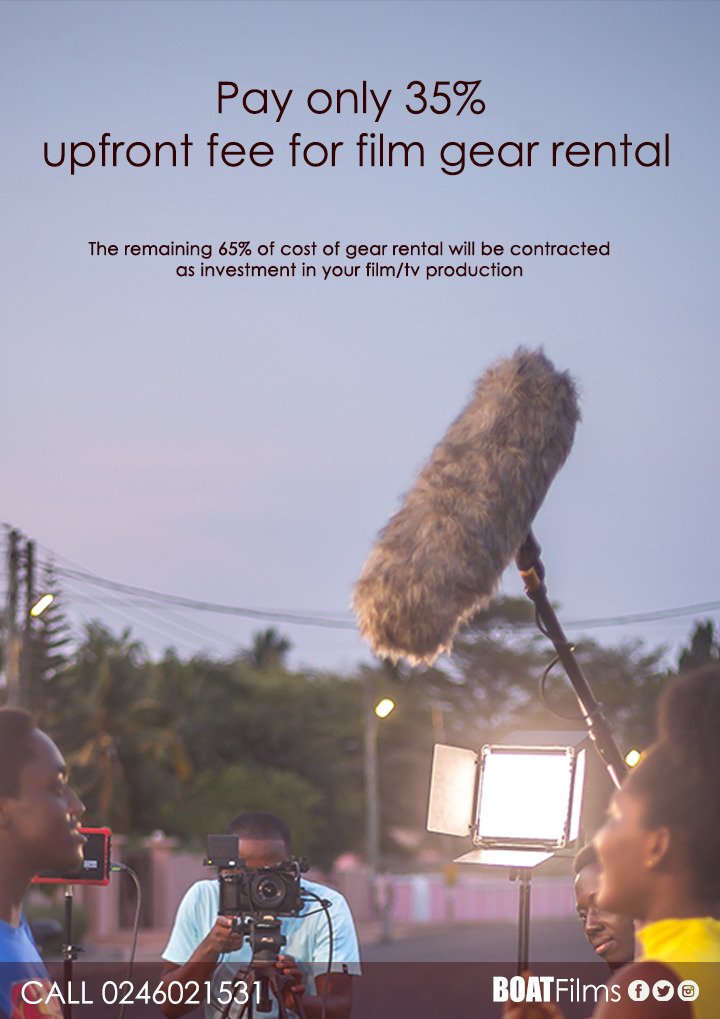Featured Articles
GUESTBLOG: Ghanaian Cinema After Independence (1957-1970)
Published
4 years agoon
By
Team
After Ghana gained independence, Dr. Kwami Nkrumah, President at the time, saw the potential film had so he nationalized the production, exhibition and distribution of film so that Africans could have control and access to the medium. In the process of nationalization, the Government purchased the West African Pictures Ltd (A film exhibition and distribution company) under the Industrial Development Company (IDC) set up by the Government at a cost of £275,000.00; which was later joined in the mid 1960s to the Gold Coast Film Unit to form a new production unit the Ghana Film Industry Corporation (GFIC) (Maters, 2003, unpublished report).
Nkrumah equipped the corporation with infrastructure such as the Lebanese-built cinema, a soundstage which was the biggest in Africa at the time, brought new film equipment, built an editing suite and celluloid film processing unit and sent Ghanaians to London(England), India and U.S.S.R ( Union of Soviets Socialist Republics aka Soviet Union now Russia Federation) to train in filmmaking. Nkrumah believed that the medium of film was a very powerful tool that could be used to shape the thinking and mid-set of Ghanaians from the colonial mentality of inferiority complex instilled by the colonialists. President Nkrumah’s interest in film was so much that he had a personal studio at the Flagstaff house; his office where his recordings were made and transmitted to the people of Ghana. He read every script that was written, personally made corrections to them before they were shot; he even viewed the first cut of the films before they went into final cut (Ellerson, 2013). According to Hagan (1991)
Nkrumah wanted to establish a national culture industry in cinema which would be used to build strong cultural bonds among the various ethnic groups in the country. This was not an easy task because of many years of British Colonial divide and rule tactics that divided native people along ethnic and cultural lines. He also provided enormous funding for film production like other mass media in the country (Ansah, 1991). Filmmakers were tasked to produce images and text that would reshape and redefine the national psyche of the people and also to unite the nation.
The Ghana Film Industry Corporation (GFIC) produced many films, newsreels, documentaries and feature films. The Corporation was a well structured Cinema Industry which comprised a commercial department responsible for exhibition and distribution of films, a production unit for producing films, a technical department for acquisition and maintenance of equipments and a unit for hiring personnel. GFIC employed 260 people and capable of producing its own films and providing services for the other organizations, independent companies and producers. The corporation also imported films which were relevant to the development of cinema and the nation (Nanbigne, 2011). The GFIC distributed its films through film theatres owned by the corporation across the country with six located in Accra alone including Rex, Regal, Roxy, Plaza and the Kanda Film Theatre – which was located on the premises on the corporation’s premises now occupied by TV3 Network. There was a Rex in Asamankese and Dam Cinema in Akosombo (Masters, ibid, personal conversation).
The nationalization of the film industry was to serve political and nationalist goals. It was used to propagate the Pan-African ideologies of Nkrumah in other parts of Africa; films were shown in other countries on the continent to unify them. There were films which also concentrated on economic development and subjects of social concern like, education, sexuality, gender, traditions occasionally. Most of the films were documentaries inherited from the British colonialists. Newsreels and documentaries which were on early independence activities, Nkrumah’s travel, several development projects such as the construction of the Akosombo Hydroelectric Dam (Nanbigne, 2011). An example was a 17-minute documentary about the celebrations to mark the independence of the Republic of Togoland on 27th April 1960 called Ablode (1960). Operation Congo (1960) was a film that documents the assistance Ghana provided the Republic of Congo during its political crisis. Humanitarian supplies and a contingent of police and military were sent there in the process. Rev Dr Chris Hesse in a conversation with Nanbigne (2011) who was Nkrumah’s personal photography at the time was sent to Congo to record the happenings on the war front. He recalls leaving the country as a civilian and arriving there as an Army Captain in order to shoot the event.
Apart from political and Pan-African films, other films concentrated on internal policies and issues of citizenship, Nanbigne (2011) gives some examples;
“Answer for Tomorrow (1960) for example was a documentary about the 1960 Ghana National Population Census. It was made pre-emptively to communicate the reasons for the intended census and to appeal to the public for cooperation. Your police (1962) depicted the work of the Ghana Police Force and was intended to educate Ghanaians on their rights, duties and responsibilities. In a typical pedagogical style the Commissioner of Police appears in the documentary and appeals to the public for their cooperation to enable the force carry out its duties effectively.” (Nanbigne, 2011, p 169)
Other films which dealt with health, agricultural development and citizenship matters include Prevention is Better than Cure (n.d.), Malaria (n.d.), and The Housefly (n.d.). These films taught personal hygiene and prevention of Malaria. Most of the foreign films exhibited were documentaries but the local films were short dramatic fictions on a wide range of topics. Another film Alega’s Day (n.d.) was a film which had a similar narrative as the 1952 film The Boy Kumasenu, which centres on a character Alega who is convinced by his friend’s display of new clothes that life is better off in the big city, Accra but unfortunately he ends up in thievery and eventually ends up in the grips of the police. In 1964, the GFIC produced the film Hamile:The Tongo Hamlet directed by Terry Bishop and produced by Sam Aryeetey was an adaptation of William Shakespeare’s Hamlet which is set in Northern Ghana in the home of the Frafra people; an ethnic group in Ghana. The film is based on a popular stage production as performed by the students of the University of Ghana School of Music and Drama produced by Joe de Graft. Quite a number of political and nationalist documentaries and newsreels were released in English, French and Arabic which were distributed to other African countries especially those which were still under colonial rule in order to propagate nationalism and to demonstrate solidarity for these countries seeking independence
In 1966, a troop of soldiers overthrew the Government whilst Nkrumah was on his way to China. They formed a military dictatorship under the National Liberation Council (NLC). This began the retrogression of the GFIC, but not before a few popular films was produced. The military was not known to be concerned with cultural heritage through the use of film. Immediately after the NLC came into power order was given for all films that were produced under Nkrumah’s administration should be destroyed because felt they were used by Nkrumah to propagate his doctrines. According to Adjesu and Hesse in a conversation with Nanbigne (2011), Hesse who filmed most of the films said it was a very difficult directive for the workers of the corporation to comply with. So what they did was to hide some important positive films and other negatives but only burnt a few negatives to demonstrate their compliance. The NLC appointed Sam Aryeetey, a graduate and one of the pioneers of the West African Film School in Accra as the new Director of GFIC. Unfortunately the Government was not able to support commercial production of film at the corporation so Aryeetey had to seek funding elsewhere (Ukadike, 1994). There is no record explaining why this government did not support commercial film production but the GFIC was used for the military government’s own political agenda, recorded individual activities of government officials even though the previous administration had been accused of similar misuses of the corporation. The use of the media for social and cultural interest of Nkrumah’s government were lacking in this government.
Apart from a few educational films, the corporation produced mostly newsreels and documentaries for the military government. It was not until two years after the coup that a feature film was produced by the corporation, No Tears for Ananse (1968) directed by Sam Aryeetey. It is considered the first truly Ghanaian film since all the crew and cast members were Ghanaians. It was also a very significant film because it deviated from the British colonial style of filmmaking. This film lead to the beginning of the experiments of traditional narrative forms. Nanbigne continues to explain the films significance;
“For the first time, Ghanaian spectators could relate totally with what they saw. Not only did the film offer a visual inscription of a popular folktale, but the personification of the mythical master of intrigue, trickery and guile, Ananse, must have been fascinating to audiences.” (Nanbigne, 2011, p 171)
No Tears for Ananse opens with on-screen text that tell us about the importance of the storytelling among Ghanaians and that the most popular folk character, is the mythical Ananse (the spider). He is refered to as Kweku Ananse, a male among the Akans; other ethnic groups posses stories about him, with culturally specific names and is often used as a symbol of shrewdness and cunning. The films open in a bushy neighbourhood with a voice over describing Kweku Ananse as sometimes brave or sometimes cowardly. Ananse appears and tries to climb a tall cotton tree with a big gourd hanging around his neck and in front of him. It is believed that the gourd contains the entire world’s wisdom in Ghanaian mythology. Ananse wants to be the only one to have access to it so he tries to hide it up in the tree. Ananse is unsuccessful unfortunately, because he is not any wiser because no one climbs a tree with a gourd in front; he finally falls to the ground breaking the gourd, in process all the wisdom spills and scatters. The voice tells us for this reason all human beings now have wisdom (Nanbigne, 2011, pp. 171 & 172).
We are introduced to a traditional evening storytelling session. Apparently, the beginning of the film is the visualization of the story that is narrated by Ananse’s wife, Okonor and their son Kweku Tsen, who have the largest farm in the village and how Ananse schemes to enjoy the crops on the farm alone. The traditional storytelling fashion is incorporated into the film where the audience join in the narrative by encouraging the storytelling with comments, asking questions and spicing exchange with songs. This communal involvement helps in the advancement of the story in an interesting and dynamic way. We see Ananse with a group of friends under a tree the whole day drinking palm wine, singing and dancing whilst his wife and son till the farm. The song accompanied by a guitar tells of Ananse’s laziness. Later his wife comes to complain about his attitude but Ananse describes it as nagging. What is interesting here is that the film makes use of music which is a very crucial part in traditional storytelling and of this narrative as well rather than just simple background music (Nanbigne, 2011, p 172).
There is bountiful harvest; Ananse plans to consume the foodstuffs from the farm alone. He goes ahead to fake an illness and instructs his wife and the people of the village not burying him but put him on a bed and leave him under his favourite tree on the farm with a grass hatch built around his body. His plan works and every night he comes out from the hut and feeds on the foodstuffs from the farm. Soon his wife and son notice foodstuffs are missing and a report is made. No one however, believes them because stealing is alien to their culture. At this point we are introduced to another storytelling session; this time the story is taking place within the story of Ananse that we are witnessing. This story within a story is rich with performance, communal participation and rituals offers insight into the character of Ananse. This type of dynamic narrative is common in many African stories and rather than confuse the listeners, it offers difficult and new perspectives for audience enjoyment especially when storytellers modify existing tales (Nanbigne, 2011, p 173)
Ananse enjoys the farm produce for some time until his son sets a trap and catches his father Ananse. He is disgraced. The narrative ends the story with the moral lesson greed can lead to disgrace; these lessons are common with traditional African folktale. No Tears for Ananse paved the way for several experiments with local narratives and symbolisms. Ghana experienced a change in political government a year after the film’s release. Civil society put pressure on the military junta which lifted the ban on political party activities. In 1969 A. K. Busia came into power through an election (Nanbigne, 2011, p 173). Under Sam Aryeetey’s direction of GFIC, there were collaborations with his contemporaries to continue experiments with local narrative forms. On such film was I Told you so (1970) which is considered one of Ghana’s film classics.
Written by, Emmanuel Quist-Haynes (Art Director)
REFERENCES
Ansah, P. A. V. (1991). Kwame Nkrumah and Mass Media. In Arhin, K (ED), The Life and Work of Kwame Nkrumah, pp. 88-107. Accra: Sedco Publishing Ltd.
Ellerson, Beti (2013). Anita Afonu; Preserving Ghana’s Cinematic Treasures. Retrieved 8th May, 2015 from http://www.africanwomenincinema.blogspot.in/2013/12/anita-afonu-preserving-ghanas-cinematic-.html?m=1
Hagan, G. (1991). Nkrumah’s Cultural Policy. In Arhin, K (ED),The Life and Work of Kwame Nkrumah. pp. 1-26. Accra: Sedco Publishing Ltd.
Nanabigne, V. (2001). Cinema in Ghana. History, Ideology and Popular Culture. PhD thesis. Bergen: University of Bergen.
Masters, I. (2003). Cinema in Ghana – A Report. (Unpublished manuscript).
Ukadike, F. N. (1994). Black African Cinema. University of California Press.
You may like
-


GUESTBLOG: Ghanaian Cinema In The 1990s And GFIC Collapse
-


GUESTBLOG: Ghanaian Cinema From 1970-1980
-


GUESTBLOG: Ghanaian Cinema During World War II (1939 – 1945)
-


GUESTBLOG: Ghanaian Cinema From 1900-1938
-


GUESTBLOG: Another Way Ghanaian Filmmakers Can Win An Oscar® – My Opinion
-


GUESTBLOG: How Ghanaian Filmmakers Can Win An Oscar® – My Opinion















